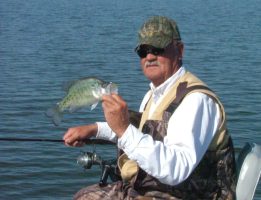Even in the dead of winter, bright sunny days often bring crappie to the shallows.
Catching Cold Crappie When the Sun Shines High
Photos and Story by Rob Somerville
By now many hardcore crappie anglers – at least those in the South – have winterized their equipment and are counting down the days to the Spring spawn.
I think they are making a grievous error.
Believe it or not, these freshwater jewels are migrating in the middle of winter along what I like to call, “the paper route.” If you get a thrill out of catching slab crappie like I do, an adrenaline rush awaits you in almost any creek-fed cove this time of year.
As cold temperatures arrive in November and early December, the schooling fish relating to deeper structure, will remain there and usually stay tighter to cover. But on a warm sunny day, many of those fish will head shallow in search of water warmed by the sun. Casting small grubs at shallow, rocky shorelines can make for some of the most action you’ve ever had on crappie waters.
The guys out on the deeper channels will stare at you like you’ve lost your mind, even as you pass them on the way to the boat ramp with a limit in your cooler.
A bright sun can warm surface water temperatures as much as five degrees higher than temperatures just a few feet down. This is especially true when the water is muddy or turbid or around structure, like stake beds or brushpile tops, which stick out of the water. They can absorb the warmth that literally radiates down into the water.

This method proved true one early December day for me last year. Refusing to waste such a beautiful day indoors, I decided to try my luck at some cold-water West Tennessee crappie.
As I idled away from the boat launch, I noticed the top of a shallow stake-bed sticking up a few inches above the surface. I hadn’t noticed the bed before, so I decided to go check it out and get a good line-up on it, in hopes of finding it again next spring.
As I approached the bed, just to humor myself, I cast my jig and float right into the middle of the protruding stakes. Before I could click the bail on my reel, the float was gone. It turned out to be a slab crappie, pushing two pounds.
In amazement that the fish was so shallow and in such cold water, I backed away from the bed a little, only to catch 8 to 10 more keepers from it.
I went across the bay to a string of shallow stake beds I usually fished in the spring. There were fish stacked on every one of them. In fact, it seemed the shallower the cover, the bigger the fish. I couldn’t believe it. I had a limit of crappie without ever leaving 3 feet of water.
I tried this several more times that winter, but it only worked on days that the sun had been bearing down on those stake beds for two or three hours. When I went out on cloudy days, I found nothing in the shallows.
However, I backed off the flat to some brush piles on the edge of the creek channel and found several fish seeming to be staging there, just waiting for the sun to come out, so they could venture shallow on a feeding binge.
Crappie pro, Garry Mason of Legends of the Outdoors Guide Service in Springville, Tennessee, said he went about it a different way. He had found the fish schooling along rock banks and caught them by casting small grubs onto the bank and slowly bringing them into the water, only to feel the firm thump of the big paper-mouth, within two or three feet from the shallow shoreline. He also found that this worked best around points, where creek channels ran in close to the bank. However, the one thing our strategies had in common was the sun factor. His strategy only worked where the bank had been exposed to several hours of sunlight.
The next winter day you journey out to the duck blind, or just go out to sink some brush for the next spring, take a close peek at the shorelines. If you look closely, particularly on sunny days, you may notice large schools of shad. This cold-blooded forage species will travel shallow shorelines feeding on microscopic animals that venture out when sunshine warms the surface.
Needless to say, I tackle every opportunity to fill the cooler with a limit of crappie, even if that requires a propane heater in the boat to revive the feeling in my hands from time to time. Some of my hunting buddies tease me for not chasing ducks, but they have no complaints when we have fish to cook for lunch when the ducks aren’t flying.
Nowadays, the light tackle should never leave your boat, even during duck season. Those warmer “bluebird” days may destroy any hope I have of killing ducks or geese, but now they just prime me up for a good day of fishing. If you don’t want to wait till next spring to fill the freezer with fillets ……… don’t.
The opportunities will arise these next couple of months, but you have to be out there to get in on the action. Trust me, you’ll look at cold weather in a whole new light.
Rob Somerville, from Dyersburg, Tenn., is the Owner/Editor of Southern Traditions Outdoors Magazine. He is also a longtime member and officer of the Tennessee Outdoor Writers Association.


